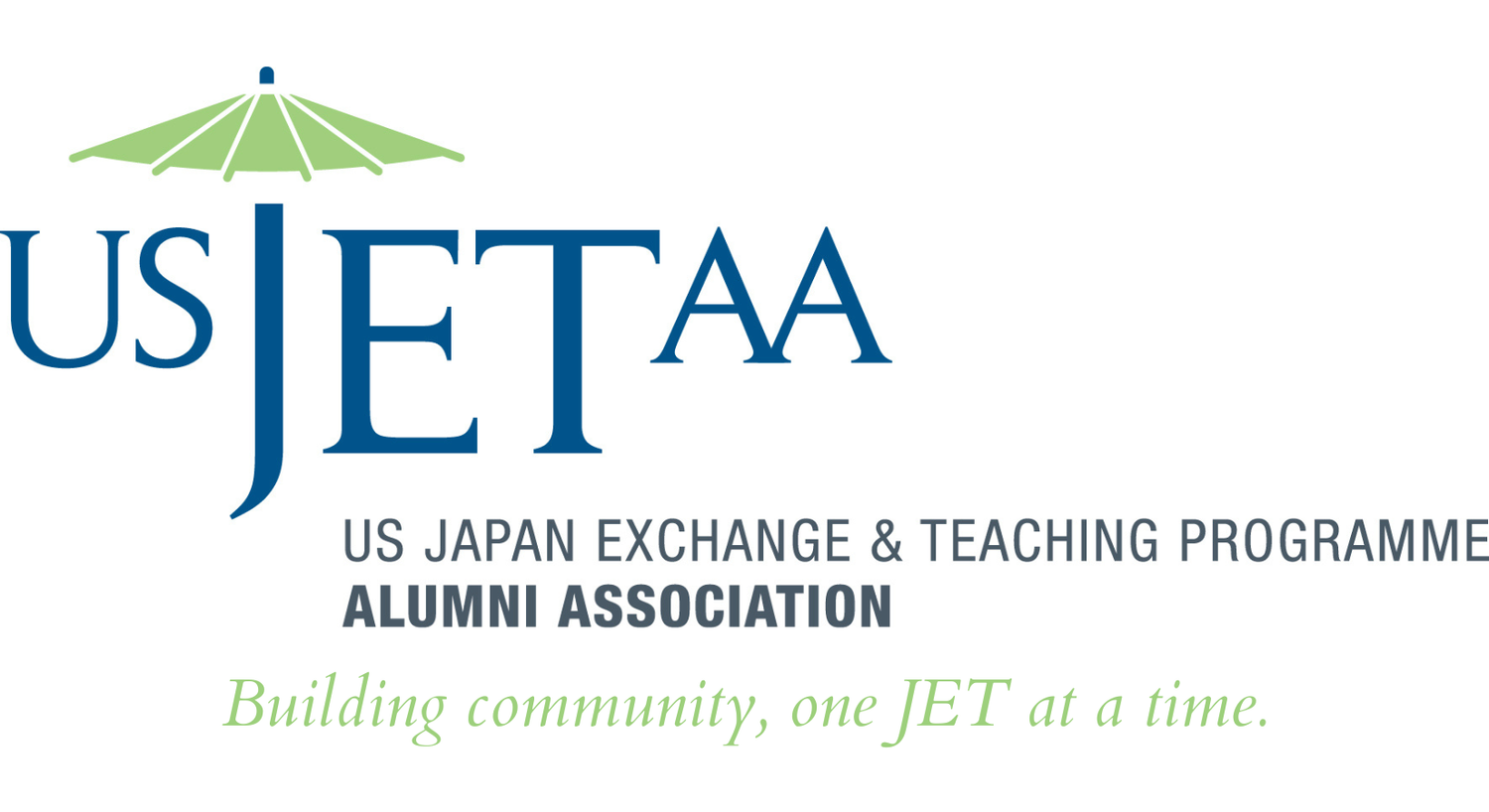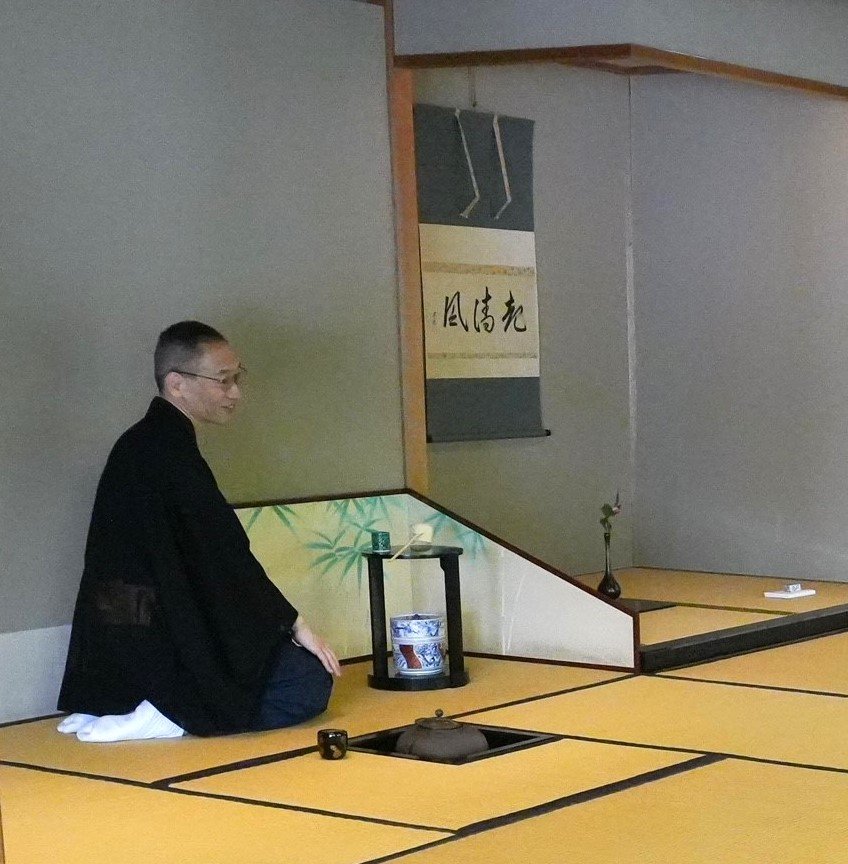JETs at The White House
In mid-April, Prime Minister Fumio Kishida and First Lady Yuko Kishida made an official visit to Washington, DC. The JET alumni community had two unique opportunities to experience their state visit.
April 9, 2024: A Special Tea Ceremony
On April 9, First Lady Yuko Kishida met with 7 Americans including 6 former JET Program participants for a tea ceremony in the Tea Room at the Japanese Ambassador’s residence led by Urasenke Foundation Deputy Tea Master Sokei Suzuki from Urasenke Chanoyu Center in New York.
Upon entering the tea room, accessed via a long windowed hall with shoji screens framing a soothing koi pond and garden, a row of black lacquered benches and tables were set before the raised tatami platform and tokonoma. Reflecting the season, as is traditional, the alcove held a single peony bud under a calligraphic scroll that read "pure wind blows" (pronounced せいふうおこす / 清風起こす).
Guests were invited to sit at the benches as the First Lady welcomed them, saying “I would like to enjoy today’s tea ceremony and feel the joy of being here with you today, in the spirit of “Ichigo Ichie” (a once-in-a-lifetime encounter), as taught in the Japanese Tea Ceremony.” Attendees from the JET Alumni community included: Neave Denny St. Fleur, Laurel Lukaszewski, Lauren Mosely, Elizabeth Olchowski, Ryan Shaffer, and Nicole Uehara. They were joined by Frank Feltens, Curator of the National Museum of Asian Art, and members of the Urasenke Tankokai Washington D.C. Association. All of the invitees have played a long role in the relationship between the United States and Japan, supporting both the JET Program and the broader US-Japan relationship.
The exquisite tea ceremony started with a celebration of the season with handmade wagashi in the shape and color of a cherry blossom, paired with matcha made with green tea powder from Kyoto flown in for the event. Participants had the opportunity to examine the beautifully made matcha Wajima-nuri Natsume (lacquered tea caddy holding the green tea), called むびょうwhich can mean either six gourds (六瓢) or no sickness (無病), with six gourd pattern, along with a selection of handmade ceramic tea bowls.
After the tea ceremony, Deputy Chief of Mission Koichi Ai, moderated a discussion with Mrs. Kishida and attendees about how the JET Program influenced current career activities, interest in expanding networks among JET Program alumni in the US and Japan, and sharing Japanese culture with other Americans after returning home from working in Japan. Mrs. Kishida remarked, “It is wonderful to know that the exchanges have been continued even after each JET participant completes the program.”
At the close of the event, Mrs. Kishida gave each participant a small token of candles made in Ishikawa Prefecture, which suffered an earthquake on January 1, 2024.
April 10, 2024: The Arrival Ceremony at The White House
On April 10, 2024, U.S. President Biden and Japanese Prime Minister Kishida convened for an important U.S.-Japan Summit at the White House. Recognizing the importance of people-to-people exchange, many of the individuals invited to attend the Official Visit White House South Lawn Arrival Ceremony honoring His Excellency Kishida Fumio, Prime Minister of Japan, and Mrs. Kishida Yuko were alumni of important exchange programs like the Japan Exchange and Teaching (JET) Program.
This bustling event took place on The White House South Lawn. Starting with a long line on the east side of the White House, guests were ushered through security and into the East Wing of the White House, exiting onto the South Lawn by way of a lovely tulip garden. As guests arrived, each had an assigned section where they could take their seats or stand, depending on the location. A press stand full of reporters and cameras was set up in the middle of the South Lawn, facing the porch and sweeping staircases of the White House and temporary stage and podium. Military regiments and marching bands were preparing for the start of the event. The excitement was palpable as guests chatted and spotted friends or flipped through the program's lush paper explaining the event's customs and schedule.
When it was finally time, guests were instructed to take their seats. The affair opened with a moving koto performance, followed by all the pomp of a military band. All six military service branches, the Army, Marine Corps, Navy, Air Force, Space Force, and Coast Guard, were represented in a procession carrying the American and Japanese flags around the White House and up the stairs of the porch. Next, a regiment dressed like the Continental Army marched in front of the stage, playing traditional instruments and songs (such as Yankee Doodle).
The Japanese delegation arrived, followed by President Joe Biden and First Lady Jill Biden. All rose to observe the playing of the national anthems of both countries. President Biden and Prime Minister Kishida then left the podium for a tour of the military regiments before returning to the podium. Each leader made remarks in their native language, followed by consecutive interpretations.
In his remarks, Prime Minister Kishida spoke earnestly about the gift of cherry blossom trees from Japan to Washington, DC, in 1912, symbolizing the enduring friendship between Japan and the United States. The cherry blossom trees are an important symbol of the deep friendship between the United States and Japan. The cherry blossoms span both the pre- and post-WWII period, showing that even through times of strife, relationships can be renewed and strengthened. Prime Minister Kishida remarked that though the average life of these cherry blossom trees was just 60 years, they have thrived for more than 100 years, just as the friendship between our two countries has thrived. Extending that friendship into the future, Prime Minister Kishida announced a gift of 250 more cherry blossom trees for the United States' 250th birthday in two years.
The two leaders further emphasized the vitality of people-to-people exchange, underscoring the enduring partnership between the two nations and the crucial U.S.-Japan-ROK Trilateral relationship. Notably, discussions touched upon the significance of long-term exchange programs between the two countries, highlighting the role that programs like JET play as "the most effective way to develop the future stewards of the U.S.-Japan relationship." President Biden and Prime Minister Kishida announced their continued commitment to strengthening bilateral ties and addressing pressing regional and global challenges.
At the end of the ceremony, the leaders and first ladies walked to the top of the White House porch and waved to the crowd before going inside. A marching band struck up a tune and the flag bearers departed, the flags catching in the wind. Everyone made their way out of the White House in a cheerful mood. Small clusters of JET alumni took photos and selfies together, and then someone organized an impromptu lunch at a nearby restaurant, gathering alumni from USJETAA, JETAADC, and other chapters.
Following the State visit, the JET Programme was recognized in the United States-Japan Joint Leader’s Statement and also included in the official fact sheet at the end of the visit, which states, “The success of the Alliance is due to the bonds between our peoples, and our two governments recognize the achievements of organizations and programs, such as Fulbright Japan, the JET Programme, the Japan Foundation, the KAKEHASHI Project, and the U.S.-Japan Council’s TOMODACHI Initiative, Asia Kakehashi Project +(Plus), and their contributions to the alliance.”
By including the JET alumni community in these important events, both governments acknowledged the collective impact of JET alumni on the US-Japan relationship. From classrooms to boardrooms and local communities to the highest levels of government, the contributions of JET participants have shaped the US-Japan relationship for generations. JET alumni deeply understand US and Japanese culture and have acted as cultural ambassadors, facilitating cultural exchange at regional and local levels and fostering understanding, friendship, and collaboration between nations. JET alumni represent the power of citizen diplomats and the power of grassroots initiatives to shape global affairs.
Thank you to JET alumni Bahia Simons-Lane (Gunma, 2005-2007 ), Nicole Uehara (Ehime, 1999-2002) and Laurel Lukaszewski (Kagoshima, 1990-1992) for contributing this article.






